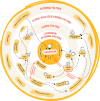School food and nutrition environments in Australian primary schools: A scoping review
- PMID: 40591617
- PMCID: PMC12212514
- DOI: 10.1371/journal.pone.0327310
School food and nutrition environments in Australian primary schools: A scoping review
Abstract
Schools are a key environment which can provide access to food, education and skills to enhance food and nutrition literacy and health and wellbeing of primary school students. This review set out to identify key features of school food and nutrition environments (SFNEs) of Australian primary schools, the barriers and enablers for optimising these features, and the impact of school socio-economic status on these features. Six health databases were searched between August 2021 and October 2024. Articles which met the inclusion criteria (n = 148) were selected for a content analysis using a school-system approach. A quality assessment and an in-depth review was then conducted on articles published post 2019 (n = 71). The content analysis identified 18 SFNE elements which were present within the classroom (n = 1), the classroom but externally-operated (n = 1), the school (n = 4), the school but externally operated (n = 6), and other elements external to the school (n = 6). The in-depth analysis revealed a complex interrelationship between these elements and the actors within these elements (students, parents, school staff, volunteers, organisations, community members, and government). As societal and school expectations evolved, this impacted the SFNE. Numerous enablers and barriers to food and nutrition education, student food consumption, and government and school policies were identified, which could be leveraged to optimise SFNEs. Fewer than a quarter of the articles considered the effect of socio-economic factors on the identified SFNE elements. SFNEs are complex, made up of numerous overlapping structural and relational elements. At the local level, the SFNE of every school is unique and school stakeholders (students, parents, school leaders and teachers) should be centralised in the development of local, contextualised strategies to improve their SFNE. State and national resourcing needs to consider financial support as well as time/capacity, personnel, expertise, and curriculum embedment.
Copyright: © 2025 Gingell et al. This is an open access article distributed under the terms of the Creative Commons Attribution License, which permits unrestricted use, distribution, and reproduction in any medium, provided the original author and source are credited.
Conflict of interest statement
The authors declare that they have no known competing financial interests or personal relationships that could have appeared to influence the work reported in this paper.
Figures
Similar articles
-
Feasibility study of Learning Together for Mental Health: fidelity, reach and acceptability of a whole-school intervention aiming to promote health and wellbeing in secondary schools.Public Health Res (Southampt). 2025 Jun 18:1-36. doi: 10.3310/RTRT0202. Online ahead of print. Public Health Res (Southampt). 2025. PMID: 40542530
-
Learning together for mental health: feasibility of measures to assess a whole-school mental health and wellbeing intervention in secondary schools.Public Health Res (Southampt). 2025 Jun 25:1-18. doi: 10.3310/GFDT2323. Online ahead of print. Public Health Res (Southampt). 2025. PMID: 40580102
-
Measures implemented in the school setting to contain the COVID-19 pandemic.Cochrane Database Syst Rev. 2022 Jan 17;1(1):CD015029. doi: 10.1002/14651858.CD015029. Cochrane Database Syst Rev. 2022. Update in: Cochrane Database Syst Rev. 2024 May 2;5:CD015029. doi: 10.1002/14651858.CD015029.pub2. PMID: 35037252 Free PMC article. Updated.
-
Unintended consequences of measures implemented in the school setting to contain the COVID-19 pandemic: a scoping review.Cochrane Database Syst Rev. 2024 Dec 12;12(12):CD015397. doi: 10.1002/14651858.CD015397.pub2. Cochrane Database Syst Rev. 2024. PMID: 39665337
-
Sexual Harassment and Prevention Training.2024 Mar 29. In: StatPearls [Internet]. Treasure Island (FL): StatPearls Publishing; 2025 Jan–. 2024 Mar 29. In: StatPearls [Internet]. Treasure Island (FL): StatPearls Publishing; 2025 Jan–. PMID: 36508513 Free Books & Documents.
References
-
- Venter C, Harris G. The development of childhood dietary preferences and their implications for later adult health. Nutr Bull. 2009;34(4):391–4.
-
- Food and Agriculture Organization. School food and nutrition. FAO. 2023. https://www.fao.org/school-food/areas-work/based-food-nutrition-educatio...
Publication types
MeSH terms
LinkOut - more resources
Full Text Sources
Research Materials
Miscellaneous



